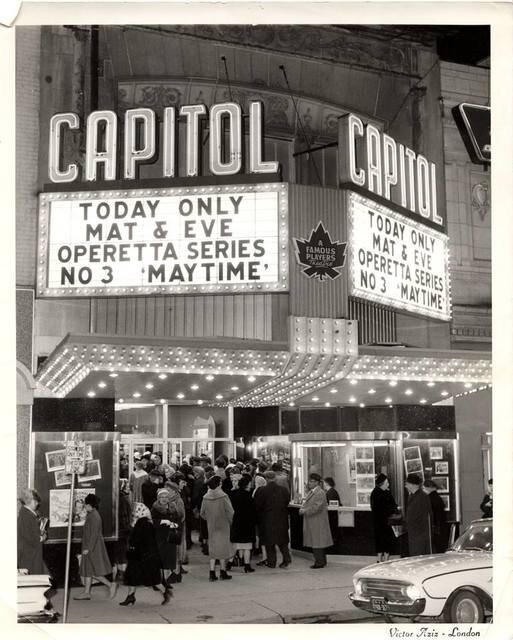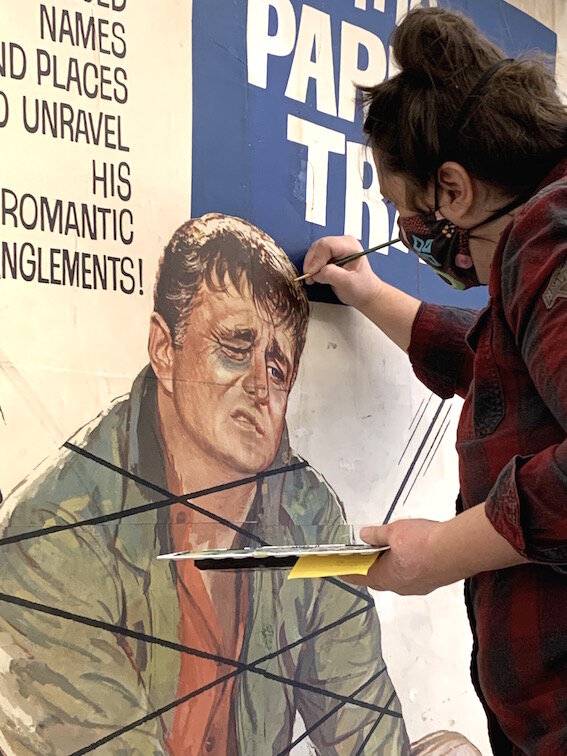Detail of The Parent Trap poster, before and after conservation treatment.
The Parent Trap, a beloved Disney film starring Hayley Mills, Maureen O’Hara and Brian Keith, was released in 1961, and movie-goers in London, Ontario, Canada must have had the chance to see it on the big screen at the Capitol Theatre at 204 Dundas Street. A large poster advertising the film is one of the few remaining artifacts of the Capitol’s heydays left in the building, and it recently underwent conservation treatment to preserve it for display in what is now part of the City of London’s City Planning Offices.
The Capitol Theatre, London, Ontario, Canada, c.1970. Photo by Victor Aziz, via Barb Trudell Dunbar
The Allen Theatre opened at this location in 1920, and became The Capitol Theatre in 1924. For 80 years, films were shown in the theatre’s auditoriums, including many of the biggest blockbusters to come out of Hollywood, and Londoners lined up on the street for admission. However, after the slow decline of movie theatres in the city’s core, the Capitol closed in 2002. In 2008 a deal was reached between the building’s owner and London City Council, and plans were made to demolish and rebuild both the Capitol and the adjacent Bowles building, restore the heritage facades, and lease the buildings for use by City offices.
During the reconstruction of the buildings, the large, brilliantly coloured Parent Trap film poster was discovered intact on the interior eastern wall of the theatre, in what would have been the lobby. Somehow this ephemeral printed paper advertisement survived the massive construction project and remained adhered, as firmly as the day it was put up, to the plaster interior wall of the building, although it was covered again during the rebuild and remained hidden until 2019.
The Parent Trap poster, before conservation treatment, in the Boardroom of the London City Planning offices.
The buildings, occupied by the City of London Planning Services (now City Planning) Offices since 2010, underwent another, smaller renovation in 2019, which saw the front room of the Capitol re-fitted for use as a board room. Although city staff were aware of the poster previously, it was at this point that the decision was made to take the opportunity of this renovation to make the poster visible again. A window frame approximately 5x7’ was built into the current wall to reveal most of the large film poster, one of few remnants of the building’s original purpose, still affixed to the original plaster of the building.
Before Treatment - large gouges.
Before Treatment - holes and abrasions.
Before Treatment - construction markings.
Before Treatment - plaster splatters.
The poster, while still vibrant and in good condition, considering all it had been through, had suffered some damage during the renovations. Deep gouges in the wall had shattered the paper in several locations, smaller gashes, dents, tears and losses were scattered over the surface, construction notations were scrawled on the paper and a thick layer of plaster dust and splatter dulled the image. Book and Paper Conservation Services was consulted about conserving and restoring the artifact, and the project was approved in early 2020.
After a long delay caused by the COVID-19 pandemic, we began conservation of the poster in early fall 2020, and completed the work at the end of November.
Adhesive application to repair breaks.
Inpainting areas of loss.
The goal of the project was to conserve and restore the poster as much as possible while keeping it affixed it its original location, preparing it for safe, long-term display in the office. This involved surface cleaning to remove dirt and debris, repairing the mechanical damages in the paper, filling material losses and performing image compensation.
Surface dry cleaning to remove debris.
More cleaning to remove plaster dust.
First the paper was carefully cleaned using soft brushes and sponge erasers to remove the dust and hard splatters of plaster. The construction notations were removed by careful scraping with a scalpel, and most of the dirt and smudges were removed with a combination of wet and dry surface cleaning. Losses were filled and the delicate lifting flaps of paper were adhered back into place. Lost areas of image were inpainted directly onto the fills using watercolour pigments to reconstruct the design. Finally the surface was coated to strengthen the paper and re-saturate the colours.
Repairs underway.
Image loss compensation along the bottom edge.
In accordance with the code of ethics of the Canadian Association of Professional Conservators (CAPC), all repairs were performed with stable and reversible conservation materials and processes, so that if in the future there is a need to return the piece to it’s original state, the treatment can be undone without causing further damage to the artifact.
The poster is now stabilized and preserved, and able to be enjoyed in it’s best state for years going forward. It will be protected behind a plexiglass barrier in the office boardroom, and visible to visitors to the building. Located in what would have been the front lobby of the theatre, it is just visible from the street windows of the Capitol building, so have a look the next time you are walking down Dundas Street, and remember the first time you saw your favourite film on the big screen. The glory days of movie theatres like The Capitol are not forgotten, thanks to those with an appreciation for our cultural heritage.
The Parent Trap 1961 Film Poster - Before Conservation Treatment
The Parent Trap 1961 Film Poster - After Conservation Treatment
The Parent Trap 1961 Film Poster - Before Conservation Treatment, detail.
The Parent Trap 1961 Film Poster - After Conservation Treatment, detail.


























